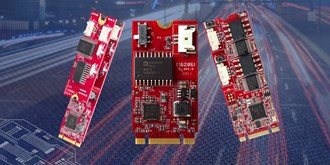Tech Talk
What is CAN Bus?

Last updated 28 April 2025
Real-time communication between machines and systems is a complex necessity in today's world of edge and industrial environments. The need for reliable communications and networking has fallen to the protocol of CAN Bus - which is short for Controller Area Network. The industrial world has been subject to this for some time, with it being developed way back in the 1980s. Since then, it's become a real common feature within technology across manufacturing, robotics, and embedded systems.
With this, let's understand CAN Bus a bit more, how it works, and why industrial and edge AI customers are increasingly using CAN Bus, especially from our partners Innodisk who have offerings in this space.
Understanding CAN Bus
At its core, CAN Bus is a message-based protocol designed to allow microcontrollers and devices to communicate with each other without a host computer. It enables various nodes (devices) in a network to send and receive messages via a shared bus system, using a method known as multi-master arbitration.
Unlike point-to-point wiring systems, which can become complicated and costly as the number of devices increases, CAN Bus allows for simplified wiring and robust communication, even in electrically noisy environments. This makes it particularly well-suited to mission-critical industrial applications.
Key features of CAN Bus
When it comes to being a “go-to” communication protocol for embedded and industrial systems, here's some reasons why:
- Robustness: CAN Bus is resistant to electrical interference, making it ideal for environments with heavy machinery or RF noise.
- Real-time communication: Messages are prioritised, so critical information gets through quickly and reliably.
- Fault tolerance: Built-in error detection and retransmission help prevent data corruption and system failure.
- Scalability: Adding devices to the network is relatively simple, making CAN Bus ideal for modular system architectures.
- Low cost: Fewer wires and simpler configurations mean reduced costs in both development and maintenance.
Use cases for CAN Bus
- Factory Automation: An example here could be production line control. CAN Bus connects PLCs (Programmable Logic Controllers), motors, and other things on the assembly line for a seamless coordination between robotic arms and inspection systems - all with the aim of ensuring components are added or inspected in the right sequence and with minimal delay.
- Robotics: Let's take AGVs (Automated Guided Vehicles) and AMRs (Autonomous Mobile Robots) as an example. CAN Bus has its use case here by managing the speed, the braking, the obstacle detection… and ultimately the communication between the subsystems of the robot. All for a safe and smooth operation across the warehouse floor.
- Transportation: Commercial fleet management is a popular industrial scenario within transportation. Trucks and heavy-duty vehicles need fuel efficiency tracking and load monitoring. CAN Bus is used for this as a protocol. What's more, the robustness of CAN Bus works in high-vibration and high-EMI environments as such.
Innodisk and CAN Bus: A Trusted Partnership
As a specialist IT distributor, we supply a wide range of Innodisk’s CAN Bus solutions, tailored to the needs of industrial and embedded customers. Innodisk’s CAN Bus cards and modules—available in PCIe, mPCIe, and M.2 formats—are designed for easy integration and long-term reliability. Key benefits include:
- Wide temperature tolerance for harsh industrial environments
- Plug-and-play drivers for Windows and Linux systems
- Support for CANopen and J1939—industry-standard higher-layer protocols
- Built-in galvanic isolation, enhancing protection and safety
These solutions are ideal for system integrators, OEMs, and industrial designers looking to build smarter, more connected applications.
Speak to Simms today about CAN Bus.